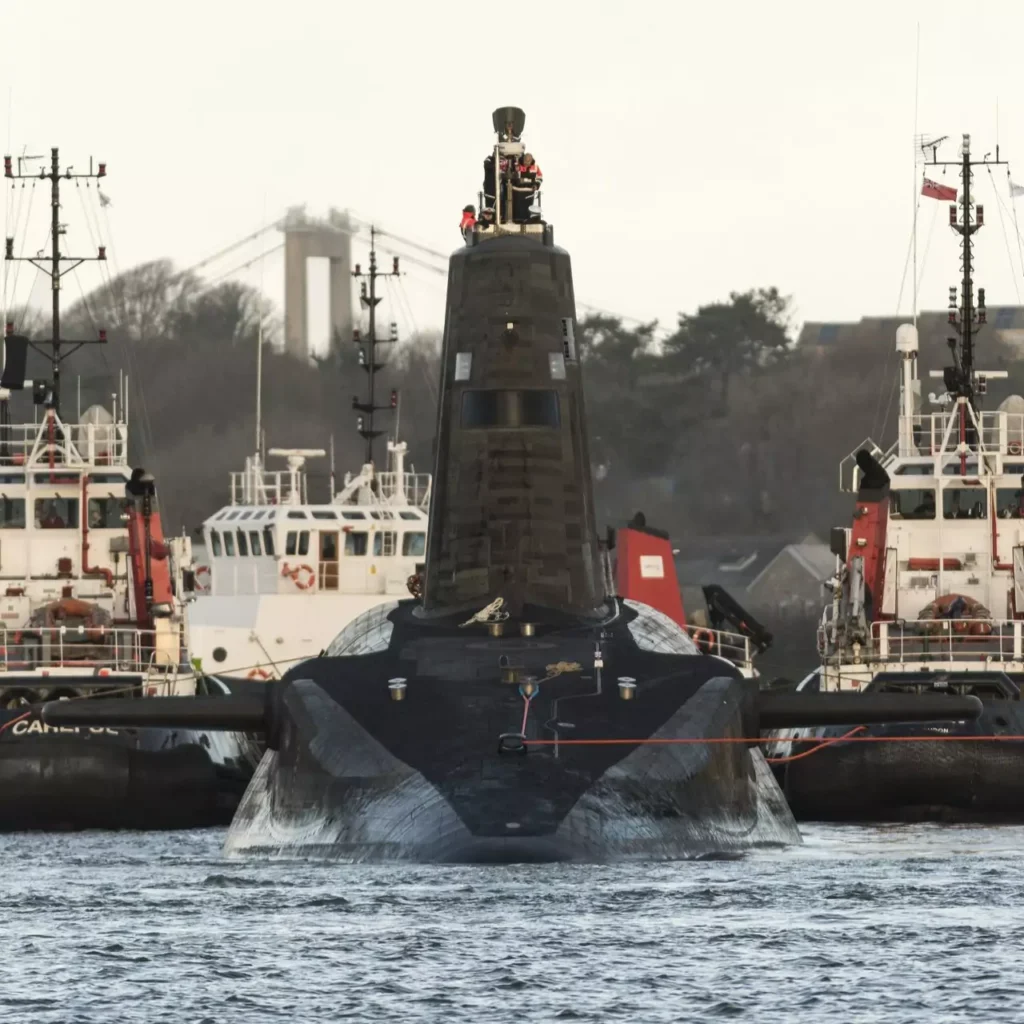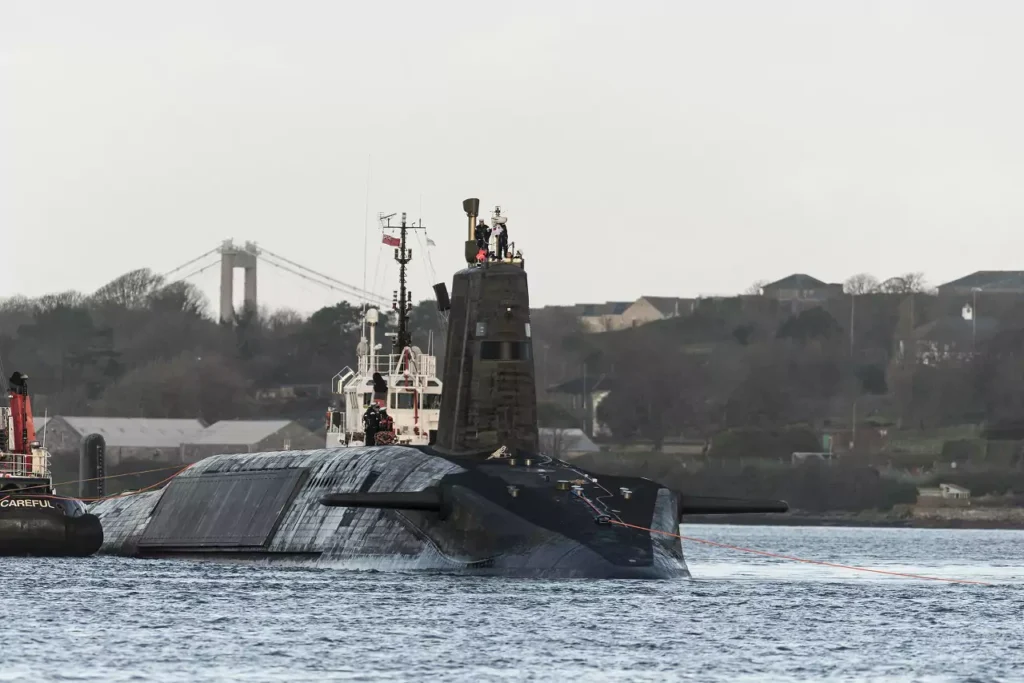Introduction
HMS Vengeance (S31) is the fourth and final submarine of the United Kingdom’s Vanguard-class strategic ballistic missile submarines (SSBN).
Ordered from Vickers Shipbuilding & Engineering Ltd. at Barrow-in-Furness, her keel was laid down on 1 February 1993. She was launched on 19 September 1998 and officially commissioned into service on 27 November 1999. Vengeance entered operational service in 2000, assigned the critical role of providing continuous at-sea nuclear deterrence.
Equipped with sixteen ballistic missile launchers, the submarine carries the Trident II D5 missile system. In addition, HMS Vengeance features four 533 mm torpedo tubes capable of launching Spearfish torpedoes against enemy submarines or surface ships up to 65 kilometers away. For enhanced defense, she is also fitted with twelve decoy launching tubes—six located on each side of the hull between the missile compartment and the sail.
Officially, her submerged speed exceeds 20 knots, though operational performance suggests capabilities of at least 25 knots.
From May 2012 to December 2015, Vengeance underwent an extensive refit and refueling period at Devonport Dockyard. Post-refit, she completed six months of sea trials before returning fully operational to strategic deterrent patrols.
Alongside her sister ships—HMS Vanguard, HMS Victorious, and HMS Vigilant—HMS Vengeance ensures the UK’s strategic nuclear deterrent remains credible and continuously effective, upholding national security within the context of global defense commitments.
Namesake
The name HMS Vengeance has a notable history within the British Royal Navy, borne by several distinguished vessels over centuries.
The first Vengeance was originally a French sixth-rate ship of 533 tons, armed with 32 guns. Captured off the Lizard by Captain John Elliott commanding HMS Hussar (28), she was commissioned into the Royal Navy retaining her original name. Ultimately, she ended her service as a breakwater at Plymouth.
The second Vengeance, constructed on the Thames between 1771 and 1774, was a third-rate ship of 1,627 tons carrying 74 guns. She participated in significant naval battles, including the action off Ushant (July 1778), Rodney’s action off Martinique (April 1780), and the defense of St. Lucia (May 1780).
Severely damaged in the Great Hurricane of October 1780, she was repaired in England. Later, she served under Sir John Jervis in the capture of Martinique (1794) and the capitulation of Trinidad (1797). After 1802, she became a prison ship until her dismantlement in 1816.
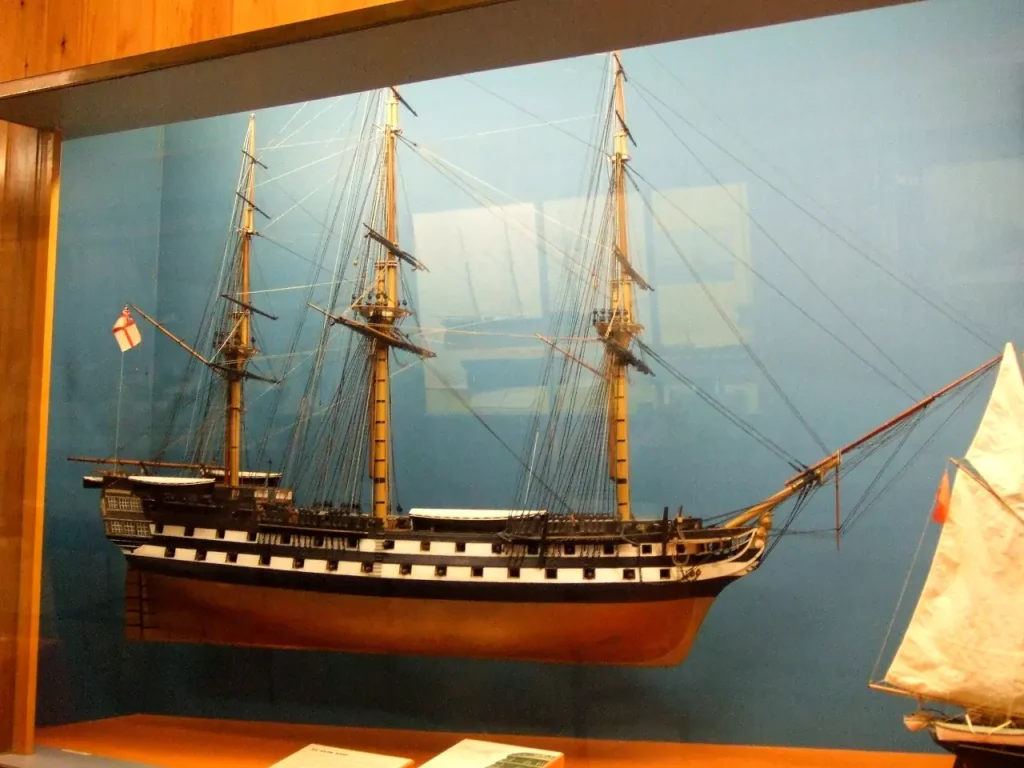
A third vessel named Vengeance, acquired at Ostend in November 1793, was an armed galleon of four guns. Her service details remain largely unknown, but she possibly formed part of the experimental anti-invasion gunboat flotilla of 1794. Her name disappeared from the Navy List in 1826 without explanation.
The fourth Vengeance was another captured French vessel—a fifth-rate frigate of 40 guns and 1,370 tons, seized by HMS Seine in Mona Passage. Used as a prison hulk in Jamaica, she remained officially listed until 1837, although records indicate her disposal in Jamaica around 1814.
A second-rate ship named Vengeance was launched at Pembroke on 26 July 1824. With 84 guns and displacing 2,284 tons, she served in the Mediterranean and participated in the Crimean War. Afterward, she served as a receiving hulk at Devonport from 1861 until her sale in 1897.

Another significant ship bearing the name was a battleship launched on 25 July 1899. Weighing 12,950 tons and armed with four 12-inch and twelve 6-inch guns, she served as flagship of the 7th Battle Squadron during World War I, including involvement in operations at the Dardanelles in 1915. She was sold in 1921.
The final notable vessel named Vengeance was a light fleet carrier from the Colossus class, completed in 1945. Initially part of the British Pacific Fleet, she repatriated former prisoners of war and served as a supply carrier. Later, she conducted helicopter trials in Arctic waters with the Home Fleet.
After a brief service with the Australian Navy (1952-1955), she was sold to Brazil in 1956, extensively modernized, and renamed Minas Gerais. She remained in Brazilian service until 2001 and was scrapped in 2004.
Official Badge
The official badge of HMS Vengeance features a red field with three daggers arranged vertically in a pile, points downward, depicted in natural colors with gold hilts and pommels. This badge symbolizes the submarine’s name, reflecting her capability and readiness to deliver decisive action. The ship’s motto, “I strike, I cover,” underscores the submarine’s dual role as both a strategic deterrent and protector.
Specifications
The Vanguard-class submarines are the backbone of the United Kingdom’s strategic nuclear deterrent, replacing the older Polaris-equipped Resolution-class submarines. The first of this class was launched in 1993, marking a significant technological advancement.
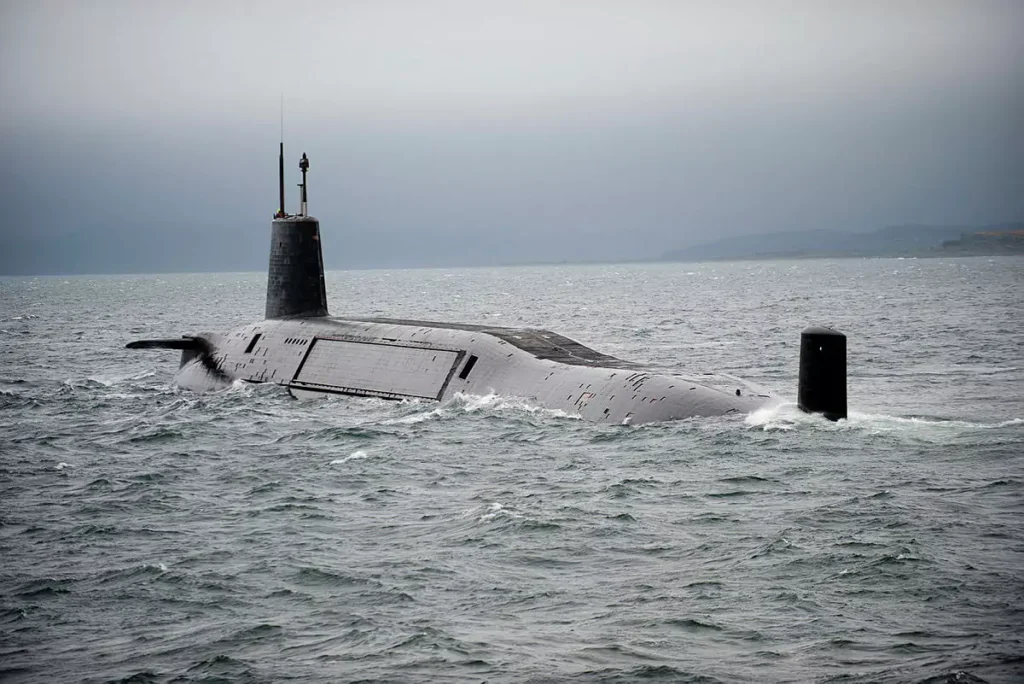
Each Vanguard-class submarine can carry 16 Trident II D-5 ballistic missiles, each missile capable of carrying up to 12 independently targetable nuclear warheads.
Although each submarine theoretically supports up to 192 warheads, operational practice has seen reductions first to 96 and more recently to 48 warheads per vessel. The Trident II missile boasts a remarkable range of approximately 11,000 kilometers (6,875 miles) and a targeting accuracy within 120 meters (360 feet).
Each vessel also carries four 533 mm (21-inch) torpedo tubes capable of firing Spearfish wire-guided torpedoes, which can engage enemy submarines or surface vessels up to 65 kilometers (40 miles) away.

To support the larger Trident missile system and a more powerful nuclear reactor, Vanguard-class submarines were substantially enlarged compared to earlier Resolution-class submarines. Advanced design features were incorporated to significantly reduce noise emissions when submerged, making them exceptionally stealthy and effective strategic deterrents.
Construction & Commissioning
- Builder: Vickers Shipbuilding & Engineering (VSEL), Barrow-in-Furness, England.
- Cost: £ 500 million.
- Ordered: 7 July 1992
- Keel laying ceremony: 1 February 1993
- Launched: 9 September 1998
- Sea trials start: 1999
- Commissioned: 27 Nov 1999
Service
- 21 September 2000, HMS Vengeance launches her first Trident D5 missile off Florida.
Assignments
| Dates | Unit | Location |
|---|---|---|
| 27 Nov 1999 - Present | 1st Submarine Squadron (SM1) | Clyde Submarine Base, Faslane |
Overhauls
The list of refueling overhauls and major maintenances received by HMS Vengeance is the following:
| Location | Start | End | Comments |
|---|---|---|---|
| HM Naval Base Devonport | March 2012 | December 2015 | Long Overhaul Period and Refuel (LOP(R)) |
Missile Launches
British submarines conduct their missile flight tests at the U.S. Eastern Test Range, located off the coast of Florida. Demonstration and Shakedown Operations (DASO) are designed to rigorously test and certify the readiness of the crew, equipment, and the missile system for operational service.
The following table displays the missile fired by HMS Vengeance:
| # | Date | Missile | Status |
|---|---|---|---|
| 1 | 21 September 2000 | Trident D5 | Successfull |
| 2 | 20 June 2016 | Trident D5 | Failure |
Photo Gallery
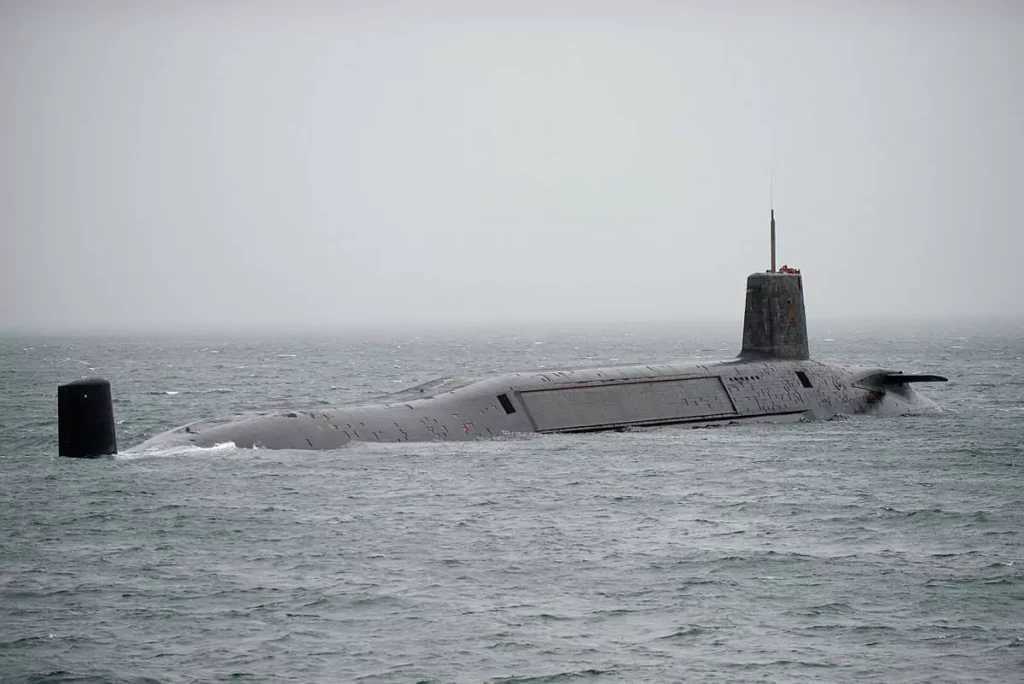
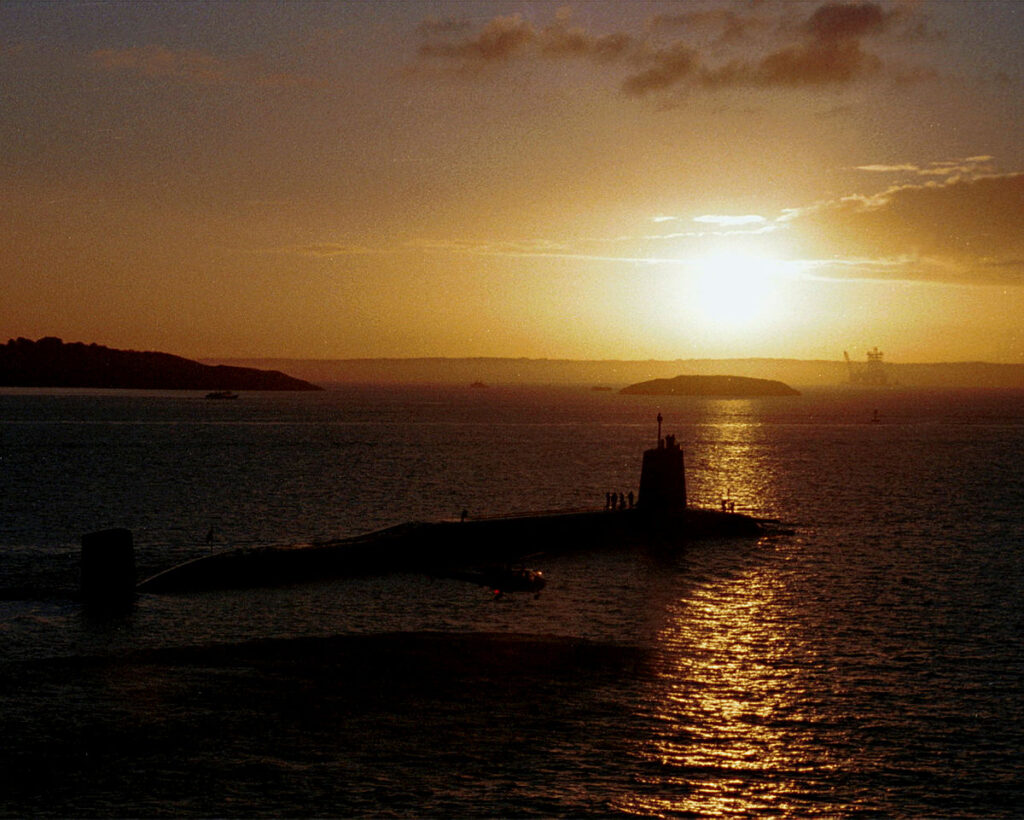

Further Reading
- Vanguard Class of Ballistic Missile Submarines
- Trident II D-5 (UGM-133A)
- 1st Submarine Squadron (SM1)
Other ships of the class:
Bibliography
- Saunders, S., Philpott, T. (2015). Jane’s Fighting Ships 2015 2016: Yearbook. United Kingdom: Ihs.
- Friedman, N. (2020). British Submarines in the Cold War Era. United Kingdom: Pen & Sword Books.
- Jinks, J., Hennessy, P. (2015). The Silent Deep: The Royal Navy Submarine Service Since 1945. United Kingdom: Penguin Books Limited.
- Weightman, A. E. (1957). Heraldry in the Royal Navy: Crests and Badges of H. M. Ships. United Kingdom: Gale and Polden.
- Burns, K. V. (1986). Badges and Battle Honours of HM Ships. United Kingdom: Maritime Books.
